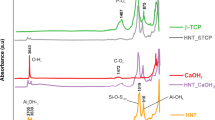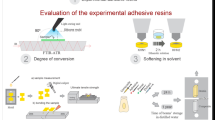Abstract
Objectives
This study aimed to evaluate the effect of Halloysite® aluminosilicate clay nanotube (HNT) incorporation into a two-step etch-and-rinse (ER) and a one-step self-etch (SE) adhesive on human dentin shear bond strength (SBS).
Materials and methods
Ten groups (n = 12) were prepared according to the adhesive system (i.e., ER or SE) and amount of HNT incorporated (5–20 %, w/v), as follows: commercial control (i.e., the adhesive was used as purchased, 0 % HNT); experimental control (i.e., the adhesive was processed through mixing/stirring and sonication similarly to the HNT-incorporated experimental groups, but without HNT); and 5, 10, and 20 % HNT. SBS testing was performed after 24 h of storage in deionized water at 37 °C. Failure modes were examined using a stereomicroscope (×40). Scanning electron microscopy (SEM) of the resin–dentin interface of selected specimens was carried out.
Results
Two-way ANOVA revealed that incorporation of HNT up to 20 % (w/v) in ER and up to 10 % (w/v) in SE demonstrated an increased SBS compared to their experimental controls. Compared to the commercial control, SBS of HNT-modified dentin adhesives was not significantly different for ER adhesives (p > 0.05) but was significantly higher with 5 % HNT in the SE adhesive (p < 0.05). Failure modes were predominantly adhesive and mixed failures. SEM micrographs of resin–dentin interfaces for ER-commercial control and ER-10 % showed a similar morphology. A thicker adhesive layer and the presence of agglomerated HNT on the resin tags were seen in ER-10 %. An increased number of short resin tags in SE-5 % compared with SE-commercial control were observed.
Conclusions
HNT addition up to 20 % in ER and up to 10 % in SE showed increased SBS to dentin compared with the experimental control.
Clinical relevance
HNT can be used not only to reinforce adhesive resins but also hold potential for the development of bioactive adhesives by the encapsulation of matrix metalloproteinase (MMP) inhibitors or anticariogenic agents.



Similar content being viewed by others
References
Koibuchi H, Yasuda N, Nakabayashi N (2001) Bonding to dentin with a self-etching primer: the effect of smear layers. Dent Mater 17:122–126
Prati C, Chersoni S, Mongiorgi R, Pashley DH (1998) Resin-infiltrated dentin layer formation of new bonding systems. Oper Dent 23:185–194
Tay FR, Carvalho R, Sano H, Pashley DH (2000) Effect of smear layers on the bonding of a self-etching primer to dentin. J Adhes Dent 2:99–116
De Munck J, Van Landuyt K, Peumans M, Poitevin A, Lambrechts P, Braem M, Van Meerbeek B (2005) A critical review of the durability of adhesion to tooth tissue: methods and results. J Dent Res 84:118–132
Lohbauer U, Wagner A, Belli R, Stoetzel C, Hilpert A, Kurland HD, Grabow J, Muller FA (2010) Zirconia nanoparticles prepared by laser vaporization as fillers for dental adhesives. Acta Biomater 6:4539–4546
Miyazaki M, Ando S, Hinoura K, Onose H, Moore BK (1995) Influence of filler addition to bonding agents on shear bond strength to bovine dentin. Dent Mater 11:234–238
Sadat-Shojai M, Atai M, Nodehi A, Khanlar LN (2010) Hydroxyapatite nanorods as novel fillers for improving the properties of dental adhesives: synthesis and application. Dent Mater 26:471–482
Solhi L, Atai M, Nodehi A, Imani M (2012) A novel dentin bonding system containing poly(methacrylic acid) grafted nanoclay: synthesis, characterization and properties. Dent Mater 28:1041–1050
Conde MC, Zanchi CH, Rodrigues-Junior SA, Carreno NL, Ogliari FA, Piva E (2009) Nanofiller loading level: Influence on selected properties of an adhesive resin. J Dent 37:331–335
Ye Y, Chen H, Wu J, Ye L (2007) High impact strength epoxy nanocomposites with natural nanotubes. Polymer 48:6426–6433
Chen Q, Zhao Y, Wu W, Xu T, Fong H (2012) Fabrication and evaluation of Bis-GMA/TEGDMA dental resins/composites containing halloysite nanotubes. Dent Mater 28:1071–1079
Bottino MC, Batarseh G, Palasuk J, Alkatheeri MS, Windsor LJ, Platt JA (2013) Nanotube-modified dentin adhesive–physicochemical and dentin bonding characterizations. Dent Mater 29:1158–1165
Li X, Liu W, Sun L, Aifantis KE, Yu B, Fan Y, Feng Q, Cui F, Watari F (2014) Resin composites reinforced by nanoscaled fibers or tubes for dental regeneration. Biomed Res Int 2014:542958
Lvov YM, Shchukin DG, Mohwald H, Price RR (2008) Halloysite clay nanotubes for controlled release of protective agents. ACS Nano 2:814–820
Price RR, Gaber BP, Lvov Y (2001) In-vitro release characteristics of tetracycline HCl, khellin and nicotinamide adenine dineculeotide from halloysite; a cylindrical mineral. J Microencapsul 18:713–722
Veerabadran NG, Mongayt D, Torchilin V, Price RR, Lvov YM (2009) Organized shells on clay nanotubes for controlled release of macromolecules. Macromol Rapid Commun 30:99–103
Feitosa SA, Palasuk J, Kamocki K, Geraldeli S, Gregory RL, Platt JA, Windsor LJ, Bottino MC (2014) Doxycycline-encapsulated nanotube-modified dentin adhesives. J Dent Res 93:1270–1276
Bottino MC, Yassen GH, Platt JA, Labban N, Windsor LJ, Spolnik KJ, Bressiani AH (2013) A novel three-dimensional scaffold for regenerative endodontics: materials and biological characterizations. J Tissue Eng Regen Med
Perdigao J, Lopes MM, Gomes G (2008) In vitro bonding performance of self-etch adhesives: II--ultramorphological evaluation. Oper Dent 33:534–549
Mortazavi V, Fathi M, Ataei E, Khodaeian N, Askari N (2012) Shear bond strengths and morphological evaluation of filled and unfilled adhesive interfaces to enamel and dentine. Int J Dent 2012:858459
Hegde MN, Hegde P, Chandra CR (2012) Morphological evaluation of new total etching and self etching adhesive system interfaces with dentin. J Conserv Dent 15:151–155
Korkmaz Y, Gurgan S, Firat E, Nathanson D (2010) Effect of adhesives and thermocycling on the shear bond strength of a nano-composite to coronal and root dentin. Oper Dent 35:522–529
Fu J, Kakuda S, Pan F, Hoshika S, Ting S, Fukuoka A, Bao Y, Ikeda T, Nakaoki Y, Selimovic D, Sano H, Sidhu SK (2013) Bonding performance of a newly developed step-less all-in-one system on dentin. Dent Mater J 32:203–211
Kemp-Scholte CM, Davidson CL (1990) Complete marginal seal of class V resin composite restorations effected by increased flexibility. J Dent Res 69:1240–1243
Abate PF, Rodriguez VI, Macchi RL (2000) Evaporation of solvent in one-bottle adhesives. J Dent 28:437–440
Shafiei F, Memarpour M (2009) Effect of repeated use on dentin bond strength of two adhesive systems: all-in-one and one-bottle. Indian J Dent Res 20:180–184
Gallo JR, Burgess JO, Xu X (2001) Effect of delayed application on shear bond strength of four fifth-generation bonding systems. Oper Dent 26:48–51
Wang Y, Spencer P, Yao X, Brenda B (2007) Effect of solvent content on resin hybridization in wet dentin bonding. J Biomed Mater Res A 82:975–983
Kim JS, Cho BH, Lee IB, Um CM, Lim BS, Oh MH, Chang CG, Son HH (2005) Effect of the hydrophilic nanofiller loading on the mechanical properties and the microtensile bond strength of an ethanol-based one-bottle dentin adhesive. J Biomed Mater Res B Appl Biomater 72:284–291
Atai M, Solhi L, Nodehi A, Mirabedini SM, Kasraei S, Akbari K, Babanzadeh S (2009) PMMA-grafted nanoclay as novel filler for dental adhesives. Dent Mater 25:339–347
Yoshiyama M, Carvalho R, Sano H, Horner J, Brewer PD, Pashley DH (1995) Interfacial morphology and strength of bonds made to superficial versus deep dentin. Am J Dent 8:297–302
Lohbauer U, Nikolaenko SA, Petschelt A, Frankenberger R (2008) Resin tags do not contribute to dentin adhesion in self-etching adhesives. J Adhes Dent 10:97–103
Schulz H, Schimmoeller B, Pratsinis SE, Salz U, Bock T (2008) Radiopaque dental adhesives: dispersion of flame-made Ta2O5/SiO2 nanoparticles in methacrylic matrices. J Dent 36:579–587
Pashley DH, Sano H, Ciucchi B, Yoshiyama M, Carvalho RM (1995) Adhesion testing of dentin bonding agents: a review. Dent Mater 11:117–125
Scherrer SS, Cesar PF, Swain MV (2010) Direct comparison of the bond strength results of the different test methods: a critical literature review. Dent Mater 26:e78–93
Braga RR, Meira JB, Boaro LC, Xavier TA (2010) Adhesion to tooth structure: a critical review of “macro” test methods. Dent Mater 26:e38–49
Kelly JR, Benetti P, Rungruanganunt P, Bona AD (2012) The slippery slope: critical perspectives on in vitro research methodologies. Dent Mater 28:41–51
De Munck J, Mine A, Poitevin A, Van Ende A, Cardoso MV, Van Landuyt KL, Peumans M, Van Meerbeek B (2012) Meta-analytical review of parameters involved in dentin bonding. J Dent Res 91:351–357
Flury S, Peutzfeldt A, Lussi A (2014) Influence of increment thickness on microhardness and dentin bond strength of bulk fill resin composites. Dent Mater 30:1104–1112
Acknowledgments
The authors thank Mr. Andre Zeitoun (Applied Minerals Inc., New York, NY, USA) for halloysite nanotubes donation. This study was conducted as part of the requirements for the MSD degree in Dental Materials at the Indiana University School of Dentistry. The authors gratefully acknowledge the valuable advice provided by the committee members (Drs. N. Blaine Cook, Tien-Min G. Chu, and Michael A. Cochran). There is a pending patent request (US 62/008,647) under the name of Indiana University–Purdue University Indianapolis that refers to the proposed innovation.
Conflict of interest
The authors declare that they have no conflict of interest.
Author information
Authors and Affiliations
Corresponding author
Rights and permissions
About this article
Cite this article
Alkatheeri, M.S., Palasuk, J., Eckert, G.J. et al. Halloysite nanotube incorporation into adhesive systems—effect on bond strength to human dentin. Clin Oral Invest 19, 1905–1912 (2015). https://doi.org/10.1007/s00784-015-1413-8
Received:
Accepted:
Published:
Issue Date:
DOI: https://doi.org/10.1007/s00784-015-1413-8




